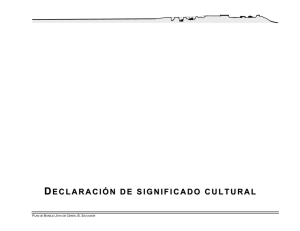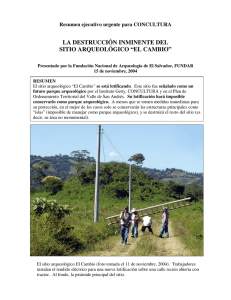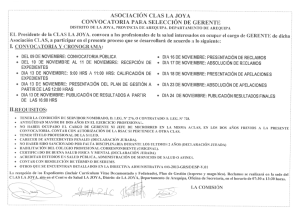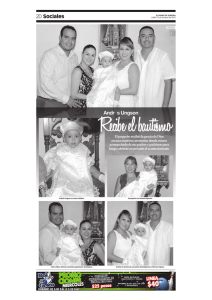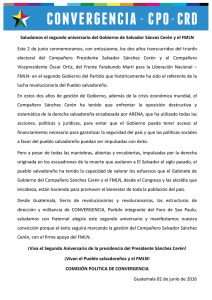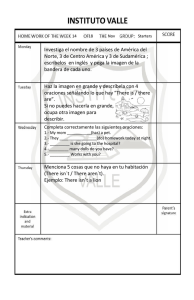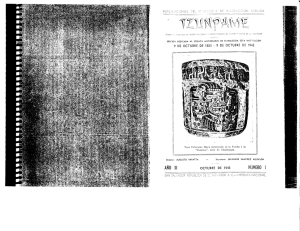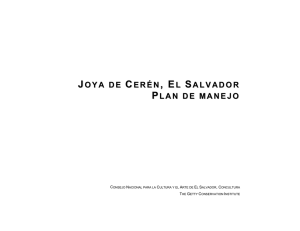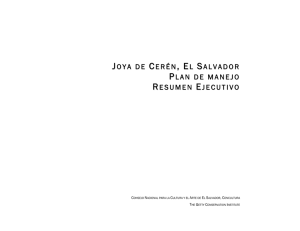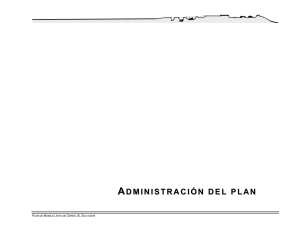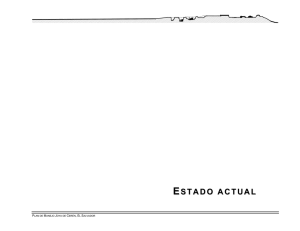Ruta ARQUEOLOGICA
Anuncio
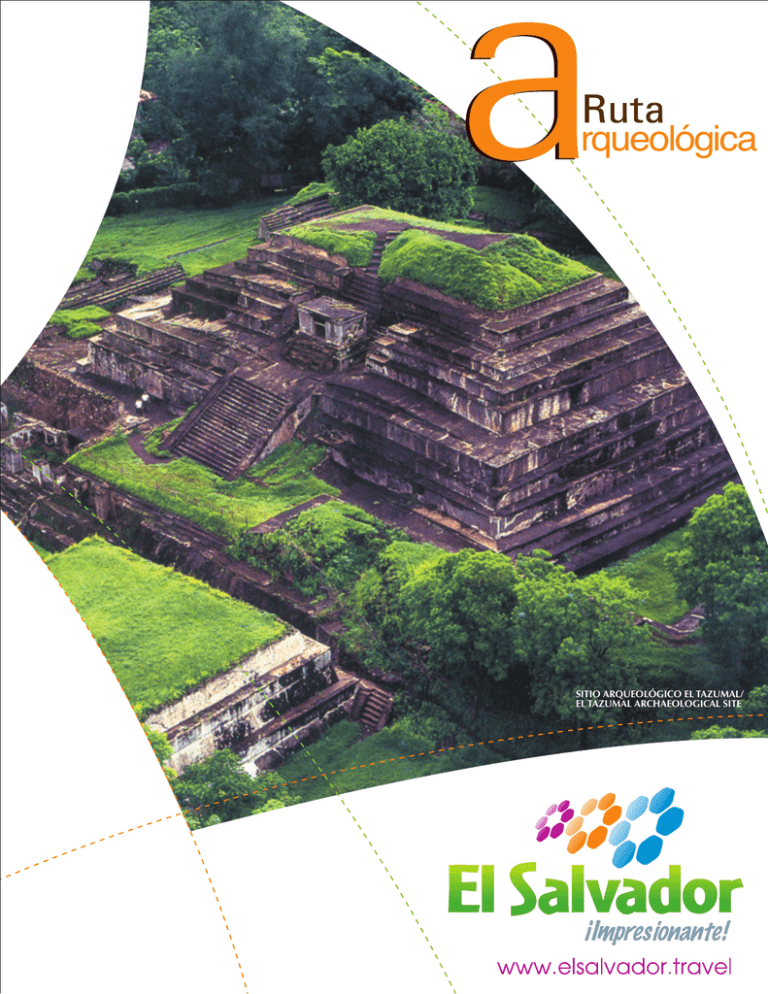
rqueológica SITIO ARQUEOLÓGICO EL TAZUMAL/ EL TAZUMAL ARCHAEOLOGICAL SITE En El Salvador existen numerosos sitios arqueológicos que forman parte de la Ruta Maya. Las civilizaciones Maya, Pipil y Lenca, formaron sus asentamientos en esta tierra, donde todavía se conservan algunos de sus centros ceremoniales tales como: JOYA DE CERÉN Ubicado en el departamento de La Libertad, a unos 30 minutos de la capital, fue declarado Patrimonio de la Humanidad por la UNESCO en 1993. Este sitio muestra la vida cotidiana de sus pobladores indígenas, interrumpida por la erupción del Volcán de Loma Caldera en el año 600 D.C. aproximadamente. Joya de Cerén tiene 18 estructuras, diez de las cuales han sido excavadas, revelando pasillos, puertas, bancas, baños de vapor, cultivos de maíz y jardines caseros. Aparentemente sus habitantes huyeron del fenómeno natural dejando prácticamente intactas sus pertenencias y hasta la comida que preparaban en ese momento. Su conservación se debe a más de 10 capas de ceniza que lo cubrieron durante más de 1,400 años, hasta que fue descubierto en 1976. SAN ANDRÉS A 32 Km. de San Salvador, y a solo 3 Km. de distancia de Joya de Cerén, se encuentra este sitio arqueológico ceremonial. San Andrés constituyó un centro regidor regional, ceremonial y administrativo entre los años 600 a 900 D.C. Ahí se encuentra un obraje de añil que data de la época colonial y que fue sepultado por la erupción del Volcán Playón en el año de 1658 D.C. Ha sido un lugar de importantes hallazgos, entre ellos, un cetro religioso elaborado en pedernal. El complejo tiene un área de aproximadamente 35 hectáreas siendo uno de los centros prehispánicos más grandes de El Salvador. Horario de visitas San Andrés: martes a domingo de 9:00 a.m. a 4:00 p.m. Hoy, Santa Ana es una ciudad de mucho dinamismo económico donde el mayor producto de cultivo es el café. También cuenta con centros comerciales muy modernos y una excelente infraestructura de servicios turísticos. CHALCHUAPA A 79 Km. de San Salvador, constituye la zona arqueológica más grande del país. En Chalchuapa se encuentran los sitios arqueológicos de Tazumal, Casa Blanca, Trapiche, Pampe y Las Victorias. A continuación, algunos de ellos: SANTA ANA La segunda ciudad más importante del país, está situada a 65 Km. al occidente de San Salvador y cuenta con una variedad de sitios que contienen restos de la ocupación del hombre prehispánico. El complejo histórico de Santa Ana TAZUMAL A 80 Km. de San Salvador, su primera referencia data del año 1892 y comprende su Catedral, su Teatro y el Palacio Municipal. fue registrado formalmente en 1940. La ocupación de Tazumal tuvo lugar desde La Catedral, declarada Patrimonio Cultural en 1995, es 1,200 A.C. Dentro de su estructura de más de 24 mts. de altura se encontraron una estructura de más de 90 mts. de longitud, de estilo tumbas con más de 116 vasijas, joyería de jade, espejos de pirita de hierro, artefactos gótico y bizantino. de juego de pelota y cerámica con forma de lagarto. Ineludible destino para de los más hermosos y con mejor acústica de El Salvador, los amantes de la arqueología, del jade y las reproducciones de vasijas antiguas. fue construido en la primera década del siglo 20 e inaugurado Horario de visitas: martes a domingo, de 9:00 a.m. a 4:00 p.m. en 1910 con una ópera de Giussepe Verdi. CASA BLANCA Sitio arqueológico que tuvo ocupación desde el año 1500 A.C., donde se han encontrado vestigios de la cultura náhuatl del siglo XV. Cuenta con un museo que exhibe 4 piedras talladas de más de un metro de altura y un taller de teñido de añil en el cual el visitante puede participar creando su propio modelo de estampado. Horario de visitas: martes a domingo, de 9:00 a.m. a 4:00 p.m. SITIO ARQUEOLÓGICO SAN ANDRÉS/ SAN ANDRÉS ARCHAEOLOGICAL SITE THE ARCHAEOLOGICAL ROUTE There are many archaeological sites in El Salvador. These are part of the “Ruta Maya”. Civilizations such as the Maya, Pipil and Lenca, settled on this land where there are still remains of their ceremonial centers such as: Joya de Cerén: Located in the Department of La Libertad, just 30 minutes from the capital, it was declared Heritage of Humanity by UNESCO in 1993. There you can see the daily life of the native dwellers that was interrupted by the eruption of Loma Caldera Volcano around 600 AD. Joya de Cerén has 18 edifices, ten of which have been excavated to reveal corridors, doors, benches, steam-baths, corn fields, and vegetable gardens. Apparently at the time of the volcanic eruption the inhabitants left their belongings and dropped everything, even the meals that had been cooking on the fire, to flee. Everything had been preserved by 10 layers of ash that covered it all for over 1,400 years, until its discovery in 1976. SAN ANDRÉS This archaeological ceremonial site is 32 km from San Salvador, and a mere 3 km from Joya de Cerén. San Andrés was the regional focal point for government, ceremonials, and administration from 600 to 900 AD. There is also a colonial-period indigo manufactory that was buried under by the “Playón” Volcano’s 1658 AD. eruption. The series of important findings at this site also include a religious scepter made of flint.The complex spans approximately 35 hectares, and one of El Salvador’s largest pre-Hispanic centers. Visits to San Andrés are from Tuesdays through Sundays, from 9:00 a.m. to 4:00 p.m. SANTA ANA The country’s second most important city is located 65 km west of San Salvador. There are various places that bear the mark of occupation by pre-historic man. The Santa Ana historical complex includes the Cathedral, the Theatre, and Municipal Palace (City Hall). The Cathedral was declared Cultural Heritage Site in 1995, and is an over 90-meter long structure, in the Gothic and Byzantine styles. The Santa Ana Theatre is one of the most beautiful in El Salvador, and has the best acoustics. It was erected during the first decade of the 20th century, and inaugurated in 1910 with an opera by Giussepe Verdi. Presently Santa Ana is a city with a dynamic economy where the most important product is coffee. There are also quite modern shopping centers and excellent tourist infrastructure and services. CHALCHUAPA Some 79 km from San Salvador, Chalchuapa is the largest archeological area in the country. In Chalchuapa there are archeological sites like Tazumal, Casa Blanca, Trapiche, Pampe and Las Victorias. Some of them are described as follows: TAZUMAL 80 km from San Salvador, it was first noted in 1892 and was formally registered in 1940. Human settlement of Tazumal began in 1200 BC. Within the over 24-meter high structure, tombs were found containing over 116 vessels, jade jewelry, pyrite iron mirrors, ball-game artifacts, and lizard shaped ceramic figures. This is a must-see for lovers of archaeology, jade and reproductions of ancient pottery. Visiting schedule: Tuesdays to Sundays, from 9:00 a.m. to 4:00 p.m. CASA BLANCA The first settlements at this archaeological site date from 1500 BC. Remains of the fifteenth century náhuatl culture have been found there. There is a museum where four carved stones are on exhibit measuring over a meter tall. Also there is an indigo-dying workshop where visitors can create their own stamped piece, hands-on. Visiting schedule: Tuesdays to Sundays, from 9:00 a.m. to 4:00 p.m. MUSEO NACIONAL DE ANTROPOLOGÍA DAVID J. GUZMÁN/ ANTHROPOLOGY NATIONAL MUSEUM DAVID J. GUZMÁN SITIO ARQUEOLÓGICO JOYA DE CERÉN/ JOYA DE CERÉN ARCHAEOLOGICAL SITE rqueológica SANTA ANA Guatemala TELAR DE CASA BLANCA CHALATENANGO Honduras CASA BLANCA TAZUMAL CHALCHUAPA CITUATÁN IGLESIA SANTIAGO APÓSTOL AHUACHAPÁN SAN ANDRÉS CABAÑAS CUSCATLÁN JOYA DE CERÉN SONSONATE MORAZÁN SAN SALVADOR SAN VICENTE LA LIBERTAD LA UNIÓN LA PAZ SAN MIGUEL USULUTÁN Oceano Pacífico SITIO ARQUEOLÓGICO SAN ANDRÉS/ SAN ANDRÉS ARCHAEOLOGICAL SITE Teléfonos Importantes / Important Telephones: • Emergencias / Emergency: 911 • Policía de Turismo / Tourism Patrol: (503) 2264-4767 • Bomberos / Fire department: (503) 2271-1244 • Cruz Roja Salvadoreña / Salvadorean Red Cross: (503) 2222-5155 • Aeropuerto de El Salvador / El Salvador Airport: (503) 2339-9455 • Migración / Migration: (503) 2221-2111 Oficinas de Información Turística CORSATUR/ Tourist Information Offices: • San Salvador: Alameda Dr. Manuel Enrique Araujo, Pasaje y Edificio Carbonell No.2 , Colonia Roma. Teléfono / Telephone: (503) 2243-7835 ext. 165 y 166 • Puerto de La Libertad: Km 34, Carretera del Litoral, Puerto de La Libertad, La Libertad. Teléfono / Telephone / Fax: (503) 2346-1898 • Ruta de las Flores: Lotificación San Fernando, Caserío El Cerrito, Km 70 carretera CA-8, Nahuizalco, Sonsonate. Teléfono / Telephone / Fax: (503) 2453-1082 • Suchitoto: Barrio El Centro, Calle San Martín No.2, Suchitoto, Cuscatlán. Teléfono / Telephone / Fax: (503) 2335-1739 MINISTERIO DE TURISMO & CORSATUR
